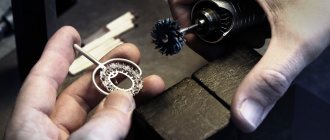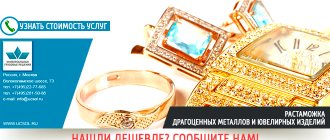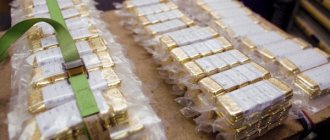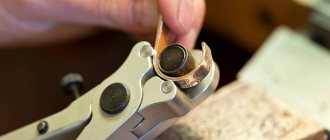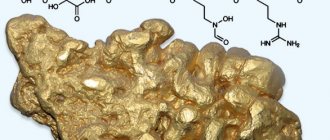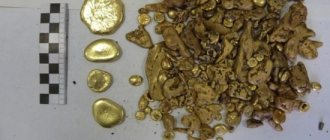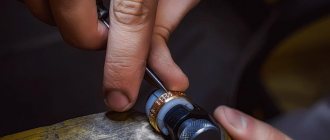Handmade jewelry from precious metals and natural minerals
Soldering alloysIn the jewelry industry, solders are distinguished by their metal bases (tin, cadmium, zinc, magnesium, aluminum, copper, silver, gold solders), as well as by melting point (low-melting, medium-melting, refractory). Solders can be made in the form of foil, tape, wire, shavings, mesh, cast rods, shaped castings, etc.
Solders must necessarily have three properties: they wet the base metals well; spreads well, providing high-quality filling of the gap; form strong and durable connections. The choice of the required solder is determined by the properties of the base metal, the operating temperature of the solder, and the soldering method.
Gold solders. Used for soldering gold and platinum jewelry. They are characterized by particularly high corrosion resistance. The gold solder sample must be identical to the product sample. One sample usually corresponds to several solders, which differ from each other in melting point and color. The color of gold solders depends on the ratio of copper and silver in them: more copper - pink solder, more silver - greenish, the same amount of copper and silver - pinkish-yellow. The addition of zinc gives the solder a green color; the addition of cadmium does not change the color of the solder. In practice, a distinction is made between white and yellow gold solders. Yellow solders are used for soldering products made of gold of yellow shades. Products made of white gold and platinum are soldered whole. Based on the amount of copper, zinc, cadmium, and tin contained in solders, they are divided into soft (low-melting) and hard (medium- and high-melting).
Table 3.2 Gold solders of 585 standard used in the domestic jewelry industry
Table 3.3 Gold solders of 750 standard used in the domestic jewelry industry
Table 3.4 Gold solders of 583 standard used at the enterprises of the Ministry of Local Industry
Table 3.5 Gold solders of 750 standard used at the enterprises of the Ministry of Local Industry
In table 3.2 and 3.3 show the brand, composition, type, and operating temperature of gold solders used in the jewelry industry. A number of gold solders of the 583rd and 750th samples (Tables 3.4 and 3.5) are used at the enterprises of the country's Ministry of Mines and Industry.
There are also gold solders of 500 and 375 samples (Table 3.6), which are used when soldering restored and repaired products. And in the table 3.7 and 3.8 give a number of gold solders used by foreign companies.
Table 3.6 Gold solders of 500th and 375th samples
Table 3.7 Recipes for preparing a number of gold solders used abroad
Silver solders. The main distinctive properties of silver solders are ductility, strength, and anti-corrosion. Their melting point is 650-810°C. They provide the required wettability of the joined surfaces of the soldered parts and fill the seam gaps well. Unlike gold, silver solders may not match the purity of the product. Jewelry industry enterprises currently use about a dozen silver solders (Table 3.9). More than two dozen silver solders of various samples (Table 3.10) are used for soldering jewelry at the enterprises of the Ministry of Local Industry. In table 3.11 shows a number of silver solders used abroad.
You can also give the compositions of a number of silver solders used by jewelers of foreign companies: 5-9 parts of pure silver plus 3 parts of brass or 7 parts of pure silver plus 3 parts of copper plus 2 parts of zinc, or 2 parts of pure silver plus 1 part of brass, or 8 parts 800 standard silver plus 1.5 parts of zinc.
Table 3.8 Gold solders used abroad
Table 3.9 Silver solders used in the domestic jewelry industry
Copper-zinc solders. Copper-zinc based solders (Table 3.12) have a satisfactory low melting point, but their ductility is not high enough. These solders are used when soldering copper products that will be subject to impact and bending. Soldering of copper products is also carried out using double brasses L63 and L60. These solders have a higher melting point; their mechanical properties are also higher.
A number of brass solders used by jewelers from foreign companies are prepared in the following compositions: 7 parts brass plus one part zinc, or 5 parts brass plus 2-5 parts zinc, or 3-4 parts brass plus 1 part zinc, or 12 parts brass plus 4 parts zinc plus 1 part tin, or 20 parts brass plus 1 part zinc plus 4 parts tin, or 18 parts brass plus 4 parts zinc plus 1 part pure silver.
Copper-phosphorus solders. This group of solders (Table 3.13) is necessary for soldering jewelry including brass, nickel silver, cupronickel, aluminum bronze and copper-nickel alloys. Their main drawback is poor ductility, to increase which tin and zinc are added to them. Copper-phosphorus solders are prepared in the form of a powdery paste.
Table 3.10 Silver solders used at the enterprises of the Ministry of Local Industry
Table 3.11 Silver solders used abroad
Tin-based solders can have the following composition: 1 part pure tin plus 1 part pure lead, or 2 parts pure tin plus 1 part pure lead, or 5 parts pure tin plus 3 parts pure lead. Paste solders Recently, when soldering mass-produced jewelry, so-called paste solders (solder pastes) based on 583-carat gold alloys have increasingly begun to be used. The application of such solders to soldered products is carried out mechanically using a special dosing device - a dispenser, which increases labor productivity and improves production standards. The use of such solders during the restoration of products makes it possible to easily eliminate defects: cracks, pores, cavities.
Table 3.12 Copper-zinc solders used in the domestic jewelry industry
Table 3.13 Copper-phosphorus solders used in the domestic jewelry industry
Table 3.14 Solders for products made of 56-carat gold
Table 3.15 Solders for products made of 72-carat gold
Table 3.16 Solders for products made of gold 94, 92 and 82 samples
Table 3.17 Solders for silver products
In table 3.14-3.16 show solders for gold products, in table. 3.17 - for silver products, and in table. 3.18 - for products made of steel, copper, brass, aluminum and tin, used by jewelers in pre-revolutionary times.
Solder placement. When applying solder, certain rules must be strictly observed. The pieces of solder should be rectangular in shape; should not be too big or too small. It is necessary to lay the solder not haphazardly, but in a certain sequence and only on one side (Fig. 3.3, c), remembering at the same time that its remnants can be easily removed. Solder should be placed on the inner, reverse sides of the products. The solder is cut with scissors and placed using tweezers. Solder can also be applied using the type of electrode supply, as in welding processes (Fig. 3.3, d). A skilled jeweler strives to solder many seams with the least amount of solder. To obtain high-quality soldered joints and remove all kinds of oxides from the soldering area, various chemicals called fluxes are used.
Table 3.18 Solders for products made of steel, brass, copper, aluminum, tin
Read more about handmade jewelry
All about metals, properties and characteristics
Metal processing
Technologies of artistic metal processing
Physicochemical characteristics
In such alloys, silver is not always the main element. It is, for example, extremely popular when soldering stainless steel or other complex metals. Everyone knows the rule - the higher the silver percentage in the solder, the more ductile and stronger the connection is when soldering.
In addition, the melting point of silver solder with a high proportion of base metal allows greater freedom in choosing the temperature range in the use of the finished product.
One of the most common silver solder compositions is as follows:
- silver – 30%;
- copper – 20%;
- zinc – 16%;
- cadmium – 33%
This composition contains cadmium, which means the alloy is quite brittle. This silver solder is used in soldering products that will not be subject to any vibrations.
If you increase the proportion of soldering silver above 50%, you will get a mixture of metals with high fluidity and excellent resistance to later stress.
Melting solder
If you decide to do without old recipes, stock up on these materials:
- container with water;
- wood mixture with coal;
- borax;
- crucible and iron hook.
Solder composition and melting point.
We melt metals in a crucible, which must be placed in a forge or heated with a blowtorch. During melting, be sure to add borax. It is important to know and follow a clear sequence of the process. The main thing is to melt refractory metals first, and only then fusible ones.
Liquid metals are constantly stirred in the crucible with a hook or wooden stick. It is better to divide the process into two stages. The crucible with molten metals is removed from the furnace, and the metal is combined with water. The resulting small drops of metal are dried and melted again, adding borax.
After final melting, pour the solder into the mold. When it hardens, roll it into strips.
The most important part of the silver soldering process at home is the transition of the alloy from liquid to solid state. First, the mixture is melted and then cast into ingus.
The preparation of the spoon is as follows: a rectangular-shaped cardboard is placed on its bottom, and a plate is placed on top of it so that its edges wrap around the edges of the spoon. Cardboard sheets are carefully crimped to form a concave-shaped bed.
Sorting of the charge is carried out on special jewelry scales, scrap silver of different samples is checked and weighed: 916 and 875, pure silver, metal, borax. The charge is divided into equal piles of approximately twenty grams, it is cleaned using a magnet to remove impurities of iron and steel.
Scrap with purity 875 is mixed with the remaining parts. Borax acts as a flux.
The proportion of silver sample No. 875 and copper is exactly 4:1 (three copper nickels and one fifty kopecks), borax is added at the rate of one part per ten parts of the charge.
Ingus or another form is greased with wax and placed next to the burner. The fact is that the melt should under no circumstances cool down. Therefore, it is poured into well-heated ingus. The mold is then placed under cold water to cool. The cooled block is removed.
A few words about fluxes
The purpose of fluxes is to protect the soldering metal from the effects of oxides by isolating the soldering area from air. The most common composition of fluxes for repairs is a mixture of potash and borax in equal proportions; sometimes soda is used instead of potash.
To obtain powdered borax, you must first dry the aqueous solution of borax. It is better to do this on a regular gas stove in a porcelain evaporation container.
Once the solution turns into crystals, they need to be ground to a powder. Flux must be removed after soldering with a weak heated acid solution.
